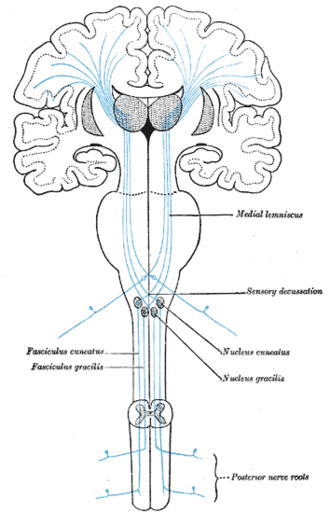Pathway of the posterior spinal cords
The lemniscal system (posterior spinal cord pathway, tr. spino-bulbo-thalamo-corticalis) is a three- neuron senzitiv spinal system. Its function is the transmission of information from skinreceptors and the musculoskeletal system:
- from Meissner's corpuscles (touch, discriminative sensation)
- from Vater-Pacini corpuscles (vibrations)
- of muscle. spindle and tendon. body (static part of propriocepcion – thrust, pressure, perception of weight, position and body in space)
Information is conducted by the spinal cord, trunk and thalamus to the cortex. The fibers of the pathway are somatotopically arranged in all sections and belong to the category of strong and fast-conducting fibers.
Track[edit | edit source]
1st cell – pseudounipolar cell of the spinal ganglion (tr. spinobulbaris)
It starts as a receptor in the periphery, runs through a sensitive spinal nerve to the posterior spinal root. It passes through the spinal ganglion without interruption and goes as an axon to the spinal cord, where the ascending collateral ends on the ncl. gracilis and ncl. cuneatus. The fibers have a somatotopic arrangement according to Kahler's rule:
- fibers from the sacral, lumbar, and lower thoracic spinal ganglia ascend in the fasciculus gracilis (medially)
- fibers of the upper thoracic and cervical ganglia ascend in the fasciculus cuneatus (laterally)
2nd cell – cell in ncl. gracilis and ncl. cuneatus (tr. bulbothalamicus)
Tr. bulbothalamicus (= lemniscus medialis) is formed by the axons of neurons from the ncl. gracilis and ncl. cuneatus. The fibers cross in the oblongata (decussatio lemniscorum), pass through the pontine and mesencephalon to the thalamus. In the thalamus it ends in the ncl. ventralis posterolateralis.
3rd cell – cell in ncl. ventralis posterolateralis of the thalamus (tr. thalamocorticalis)
The axons of these cells pass through the posterior arm of the capsula interna (radiatio thalami centralis) and end in theprimary sensitive cortical area (gyrus postcentralis area 3, 1 and 2).
Damage to fibers of the lemniscal system[edit | edit source]
- tactile disorder (the patient is unable to distinguish the size, shape and surface of the held object)
- discriminative hearing disorder (inability to distinguish the distance between two points on the skin surface)
- disturbance of vibration sensation (the patient does not feel the vibrations of the tuning fork on the skin)
- ataxia (missing muscle tension information)
- pain and heat perception preserved
Links[edit | edit source]
Related Articles[edit | edit source]
- Sensitive pathways of the CNS
- Posterior spinal cord syndrome
- Traumatic spinal cord syndromes
- Spinal tracts
- Spinal cord
References[edit | edit source]
- GRIM Miloš, DRUGA Rastislav et al. Základy anatomie, 4a Centrální nervový systém. 2.vydání. Galén, 2014. ISBN 978-80-7262-938-1

